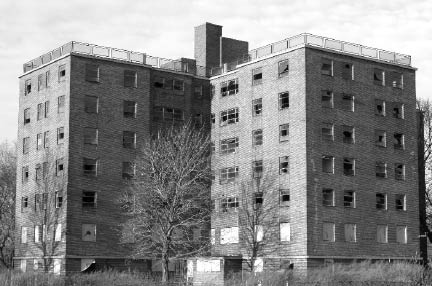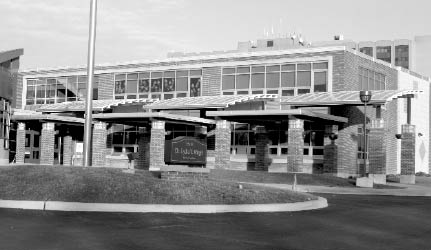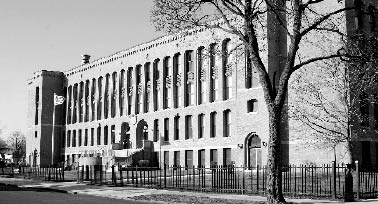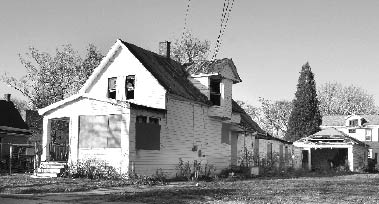Next story: Home Improvement
Street Smarts


The Glenny Drive Apartments on Buffalo’s East Side are an object lesson in poor urban planning, to be sure, but they probably do not constitute a constructive learning environment.
The abandoned public housing complex, comprising six buildings of seven stories each, looms over the intersection of Fillmore Avenue and the Kensington Expressway, directly adjacent to the Erie County Medical Center. The Glenny Drive Apartments have been empty for more than 20 years; the windows are smashed, the doorways are pried open, the walls are covered in graffiti. Part of the reason the apartments were abandoned is asbestos contamination, and that’s part of the reason they are still standing today, a public nuisance and liability, an invitation to vandalism and crime, a stark lesson in misguided urban renewal schemes and failed public housing strategies. Nobody wants to be responsible for them. Nobody thinks they can afford to be responsible.
Across the access road that loops from Fillmore Avenue into the overgrown, litter- and rubble-filled grounds—from which comes the cheerful, country-clubbish name “Glenny Drive”—is the Lydia T. Wright School of Excellence, a prekindergarten through eighth grade facility with an enrollment of nearly 800 students. There is no fence separating the school from the abandoned projects.
In contrast to the Glenny Drive projects, the Lydia Wright School is the beneficiary of a stunning makeover. The Lydia Wright renovation was a precursor to Buffalo’s $1 billion schools reconstruction project, currently entering its second phase. Administered by LP Ciminelli, the 10-year schools reconstruction project represents the largest single investment in the city’s infrastructure since the light-rail system. Thirteen schools underwent renovations in Phase 1 of the program, which lasted 18 months and cost $172 million. Phase 2 will get underway soon. And while the Phase 1 renovations are by and large successful as far as the schools themselves are concerned, the neighborhoods surrounding the schools have reaped very little benefit.
Like the light-rail system—or the selection of a site for a new university campus or football stadium, or the choice of a design for a new Peace Bridge and toll plaza—the schools reconstruction project has the potential to be transformative, not only for the Buffalo School District but for the city itself. Like all these projects, it also has the potential to be a colossal missed opportunity.
Sadly, a walk around the blocks that surround the Lydia Wright School suggests we’re missing our chance to use this massive investment in our schools to leverage revitalization of some of the city’s lost neighborhoods.
It’s not just the Glenny Drive projects. The first thing students see when their buses pull into the driveway at Lydia Wright are two boarded-up houses; they’re practically on school property. Across Appenheimer Street to the southwest is a junkyard, and more boarded-up houses. Half the houses on Chelsea Place are dilapidated and many are empty. It’s not a friendly-feeling neighborhood for young children; it’s not a neighborhood where parents would be comfortable having their children walk to school.
Which means it’s not a neighborhood where anyone is likely to choose to live. Who would buy a house next to an abandoned housing project? Who cares if the neighborhood school has a new gymnasium, new computer labs, a new roof, new classrooms and new systems throughout? Who cares if it’s state-of-the art? The neighborhood looks and feels unsafe.
A maintenance worker at the Lydia Wright School told Artvoice that the school is generally on “lockdown.” He said that kids are bussed in and out and all of the doors to the school are locked during the day. If a child goes unaccounted for, teachers and teacher aides fan out into the surroundings until the missing child is found. It sounds more like a prison than a school.
It’s not just the Lydia Wright School
A mile or so away, the neighborhood around the Harvey Austin School—another successful Phase 1 renovation—hasn’t fared much better. The school looks great, but it’s a gem among the rubble of a neighborhood that has been on a long, downward slide. The surrounding streets remain among the most blighted and crime-ridden in Buffalo.
The neighborhood surrounding East Comprehensive School, also a Phase 1 renovation, is similarly blighted.
Some neighborhoods don’t require much investment—North Park Elementary School, for example, also a Phase 1 renovation, is situated in a stable, prosperous community. But most of Buffalo’s public schools, and a majority of those scheduled for renovations, are in neighborhoods that desperately need help.
From initial proposal to signed contract, the project coordinator, Ciminelli, promised to work with community groups, city government and private partners to facilitate improvement in the neighborhoods surrounding the schools targeted for renovations. From day one Ciminelli described joint schools reconstruction project as a “development” project, not merely a construction job.
While acknowledging that the first priority of the schools reconstruction project is educational facilities, Ciminelli’s successful proposal posed this rhetorical question: “How can we, as the Ciminelli team, help our Schools and neighborhoods to address [children’s] needs and enrich our community? After all, aren’t we just the building contractors?”
The proposal goes on to provide answers to that question: Ciminelli can contribute to the revitalization of the neighborhoods surrounding targeted schools by helping to identify funding sources the city, community groups and housing agencies might use to invest in neighborhood infrastructure and housing stock; by encouraging its financial partner, Citibank, to facilitate low-interest loans for home purchases and improvements in designated neighborhoods; by coordinating with the city’s Office of Strategic Planning so that demolitions and neighborhood improvements around the rehabbed schools might be scheduled at the same time that Ciminelli’s subcontractors are working on-site, in order to achieve some efficiencies and maybe even shared bidding processes.
“There was an expectation that as we rebuilt the schools, we were going to rebuild the neighborhoods around them,” Masten District Councilmember Antoine Thompson told Artvoice. The Masten District, home to some of the city’s most blighted neighborhoods, comprises several schools targeted for reconstruction, including Lydia Wright. “And that has not happened.”
Why not? And what can the city and the school district do to make sure that when construction season begins in a month or so and Ciminelli initiates Phase 2 of the project, we don’t miss another huge opportunity to improve the neighborhoods which need attention most?


And it’s not just Ciminelli
Ciminelli has been in something of a defensive posture in recent months regarding its performance in Phase 1. It has been faulted for downgrades in material quality, for being slow to respond to complaints about poor workmanship and for a backup in performing what it calls “add-ons” and what the Joint School Construction Board calls doing what should have been done in the first place according to the contracts. Ciminelli hasn’t done any favors to its public image—always controversial to begin with—by crying poor, claiming that an unforeseeable rise in construction costs has made it nearly impossible to realize the full scope of the projects as envisioned when construction began 18 months ago.
All that makes it easy to look at the blighted neighborhood surrounding a school like Lydia Wright and say, “What happened to ‘the Promise’ that was the central theme of Ciminelli’s initial proposal? ‘The Promise to Our Children’? ‘The Promise to Our Neighborhoods’?”
But it’s not fair to lay all the blame at the feet of Ciminelli. The company pledged to facilitate neighborhood redevelopment, but strategic planning is the city’s prerogative.
“First and foremost the goal of the project is to create 21st-century learning environments for the students,” said Ciminelli spokesman Kevin Schuler. “You can never get away from that aspect of the project—that is our priority above all else: What are you doing with the schools themselves, how do you get the most bang for the buck out of the program?”
Beyond that, says Schuler, Ciminelli has committed its own money to fund at least one neighborhood revitalization program. He says that his company’s primary investment in neighborhood revitalization thus far has taken the form of a $500,000 commitment to fund the Buffalo Niagara Jobs Initiative, which is a pre-apprenticeship program designed to prepare untrained workers to join the trade unions’ apprenticeship programs. Ciminelli is identifying derelict houses nearby the schools renovated during Phase 1, Schuler explained. The trade unions will use these houses as classrooms.
“So they’re going to rehab these houses and put them back on market,” Schuler said. “It’s a twofer—on the one hand we’re going to train people who aren’t quite ready to enter the trades. Then the flip side is, when you’re done you’re going to have rehabbed houses ready to go to market—houses that otherwise would have been demolished.
“We all believe that housing is going to be the key to neighborhood redevelopment,” Schuler added. “You’ve got a brand new school, now you need to convince families that they want to live nearby those schools. This is one way we’re doing our part.”
According to Schuler, the Buffalo Niagara Jobs Initiative acts as liaison with the city’s numerous housing agencies. Ciminelli itself, he said, has reached out to the various community groups and block clubs representing the neighborhoods surrounding the schools—though the vast majority of block clubs and community groups from the neighborhoods around Phase 1 schools told Artvoice that they had never been consulted by Ciminelli and had never been asked for their input on how school renovations might be used to leverage improvements throughout the neighborhood.
But communication is a two-way street. There is a an ever increasing number of initiatives to improve infrastructure, housing and general quality of life on the East Side. Some are huge—the St. John Fruit Belt Community Development Corporation, led by St. John’s Michael Chapman, for example, is working on a huge housing redevelopment project; another ambitious housing project is planned around the recent renovations of St. Stanislaus’s church, school and community center in the Fillmore District.
Smaller, community-based initiatives are also proliferating—see the sidebars for a few examples—and the activism of City Housing Court Judge Henry Nowak is beginning to draw more attention to housing issues, too.
“Really what’s lacking is a bigger plan to tie it all together,” Schuler said. “That’s what needs to come out of the city’s Office of Strategic Planning and the Board of Education.”
Antoine Thompson is pushing for a number of projects that surround schools in his district targeted for Phase 2 renovations. He’s asking the city to demolish a nursing home near Bennett High School which burned down earlier this week. He hopes to secure funding to build new homes in the neighborhood surrounding Buffalo Traditional High School, which is slated to become the new performing arts magnet school. He has requested that the city resurface streets and sidewalks on Glenwood and Woodlawn, as well. All of this work would be paid for, he says, with a combination of federal block grant money and the city’s ordinary appropriations for such improvements.
“This is a great time, with the new mayor in place and a new construction season about to begin, to make sure that we make the necessary adjustments to restore the neighborhoods around those schools,” Thompson said, adding that the first step is to coordinate the various branches of city government and ensure that they are all adhering to a long-range master plan—the plan that Ciminelli’s Kevin Schuler says the city seemed to lack during Phase 1.
Public Works Commissioner Joe Giambra recently told Thompson that it would cost $70-100 million to rehab every street and sidewalk in the city. In other words, maybe $10 million a year over the 10-year life of the schools reconstruction project. That may be too large a percentage of the city’s yearly block grant allowance of $20 million to direct toward one project—Buffalo has no shortage of dire needs—but surely in combination with the city’s existing budget for street-level improvements, that’s a reasonably attainable goal. That’s the sort of comprehensive effort that would make a perfect complement to the schools reconstruction program.
“We have to take care of our internal processes first,” Thompson said. “We have to make sure our city government people are working together, that we’re directing our resources internally in the proper way. That’s first base. Then we can push Ciminelli to do their part.”
Putting the neighborhood in “neighborhood schools”
There are a number of cities which have managed to coordinate investment in schools with investment in surrounding neighborhoods. In Rochester, for example, recent school renovations were matched by basic improvements in sidewalks and streets within several blocks of the targeted schools.
In Milwaukee, a public-private partnership was formed to realize a $20 million revitalization of a neighborhood, concurrent with the construction of a new elementary school. The new school, one block away from the school it replaced, cost $11 million; the remaining $9 million was used by nonprofit development partners to tear down 32 dilapidated houses and construct 65 new-builds. Eventually the old school was torn down to make room for 15 more houses, built by a private, for-profit developer.
In fact, community development focused around investment in schools has become something of a national trend. In California, developers are so eager to tie new housing to first-rate schools that they have in some cases offered to build schools at their own expense and deed them to the local district.
We can do better
“We can do better, of course we can,” said Ciminelli’s Kevin Schuler. “We’re talking to lots of city agencies and to the state delegation. If the city or Strategic Planning or whoever has ideas on how they want to leverage the schools project to rehab the surrounding neighborhoods, we’re certainly open to it.”
In December Tim Wanamaker, director of the city’s Office of Strategic Planning, told Artvoice that the city was not working with Ciminelli to coordinate neighborhood redevelopment. Nonetheless, he added, the city was doing what it could to direct funds toward the areas surrounding schools renovated during Phase 1. Half of the community development block grant money dedicated to street and sidewalk improvements—about $500,000—had been spent in the vicinity of Phase 1 schools. Five houses within 400 feet of Phase 1 schools had been designated priority demolitions and taken down.
Federal money from the HOME, or Housing Opportunities Made Equal, program have been committed to dozens of new-build, rent-to-own and rental properties nearby schools renovated during Phase 1 or slated for renovation in Phase 2.
Peter Cutler, communications director for Mayor Byron Brown, says that the new administration is currently taking stock of how the Masiello administration worked with Ciminelli and the Joint Schools Construction Board. He says that Tim Wanamaker’s office is doing an audit of how the city should best direct its own budget, community development block grant funds and any other available money to take advantage of what has already been accomplished in Phase 1 and what is about to happen in Phase 2. A coordinated plan of attack is a priority, Cutler says, something the new mayor has communicated to all parties in his first few meetings with Ciminelli and the JSCB.
“One thing the mayor has made clear in those meetings, to Ciminelli and anyone else there, is that it’s a high priority for this administration to see this project succeed,” Cutler said. “All parties will see a comprehensive plan come out of this administration. And we expect everyone who has made past commitments to this project will live up to them.”
Coordinating with the big redevelopment projects is important, but the little community-based projects matter just as much, according to Cutler, and it is incumbent upon the administration to reach out to small community groups and individuals and support them in any way they can.
After all, every little bit helps, and there’s $1 billion at stake: If we renovate Buffalo’s public schools but let the neighborhoods they occupy continue to slide into dilapidation, the schools will catch up with their surroundings sooner rather than later. What a waste that would be.
|
Issue Navigation> Issue Index > v5n11: Street Smarts (3/16/06) > Street Smarts This Week's Issue • Artvoice Daily • Artvoice TV • Events Calendar • Classifieds |









 Current Issue
Current Issue